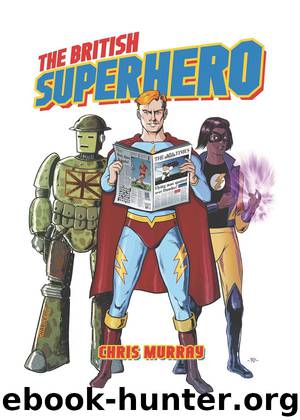The British Superhero by Chris Murray

Author:Chris Murray
Language: eng
Format: epub
Publisher: University Press of Mississippi
Published: 2017-04-04T04:00:00+00:00
Fig. 31: Gadgetman and Gimmick Kid, by Nevio Zeccara, in Lion (IPC, 1966).
Perhaps the most popular and memorable Fleetway/IPC adventure character of the 1960s was The Spider, who appeared in Lion and was initially written by Ted Cowan and later by Jerry Siegel, co-creator of Superman. Siegel took over after the second story, having written to various comics publishers seeking work. He wrote to DC Thomson and Fleetway, and it was Fleetway that replied. Siegel had left DC Comics and brought his considerable expertise in writing superhero comics to “The Spider,” which was drawn by Reg Bunn, one of the masters of the noir style in comics. The Spider was a master criminal who used technology and gadgets (like an evil James Bond) in his attempt to pull off the crime of the century. The character operated in New York from a Scottish castle that he had shipped across the Atlantic. He set about building an army of criminals, becoming a “king of crime.”
The Spider had a sinister appearance, with pointed ears and arched eyebrows. He was a consummate supervillain and a type drawn straight out of the story papers. Bunn’s atmospheric artwork was some of the best seen in British comics of the 1960s. When a criminal gang attempted to assassinate him, The Spider found the challenge of fighting villains to be appealing and so turned his talents to fighting crime. While the Spider was never really a superhero, he was yet another example of the villain being more interesting than the heroes, and like other Fleetway/IPC characters of this period, The Spider was very popular in overseas markets, including Germany, France, Spain, Italy, Turkey, and India. With the success of Valiant, Lion, and Smash! by the mid-1960s, Fleetway/IPC had responded to the new example set by Marvel, as seen by British readers in the pages of Alan Class comics when he reprinted Marvel stories. However, in 1966 there was a sudden shake-up as the Marvel license switched from Class to Odhams, giving Fleetway/IPC the opportunity to corner the market in superhero comics, with two arms of the company producing very different types of superhero comic. This created a unique situation but also planted the seeds of disaster.
Odhams and the Power Comics
Odhams had begun as a publisher of newspapers and books in the late nineteenth century, but in 1960 Cecil Harmsworth King proposed a merger between Odhams and Fleetway Publications Ltd (formerly Amalgamated Press). This may well have been closer to a takeover, and the changes, which came into effect in 1961 and continued through 1963, led to the formation of the Independent Publishing Corporation (IPC). Odhams still existed as a subsidiary within the larger company and became the publisher of a series of comics known as the Power Comics range, which included Wham!, Pow!, and Smash! This was a time when the increasing popularity of comics in America, especially Marvel Comics, started to be felt in Britain, with Odhams reprinting American material in Pow! in 1967. It was quickly followed by Fantastic (which launched on February 11, 1967) and, later, by Terrific.
Download
This site does not store any files on its server. We only index and link to content provided by other sites. Please contact the content providers to delete copyright contents if any and email us, we'll remove relevant links or contents immediately.
4 3 2 1: A Novel by Paul Auster(12287)
The handmaid's tale by Margaret Atwood(7681)
Giovanni's Room by James Baldwin(7195)
Asking the Right Questions: A Guide to Critical Thinking by M. Neil Browne & Stuart M. Keeley(5649)
Big Magic: Creative Living Beyond Fear by Elizabeth Gilbert(5615)
Ego Is the Enemy by Ryan Holiday(5295)
The Body: A Guide for Occupants by Bill Bryson(4975)
On Writing A Memoir of the Craft by Stephen King(4863)
Ken Follett - World without end by Ken Follett(4646)
Adulting by Kelly Williams Brown(4488)
Bluets by Maggie Nelson(4476)
Eat That Frog! by Brian Tracy(4436)
Guilty Pleasures by Laurell K Hamilton(4362)
The Poetry of Pablo Neruda by Pablo Neruda(4041)
Alive: The Story of the Andes Survivors by Piers Paul Read(3970)
White Noise - A Novel by Don DeLillo(3954)
Fingerprints of the Gods by Graham Hancock(3943)
The Book of Joy by Dalai Lama(3903)
The Bookshop by Penelope Fitzgerald(3777)
